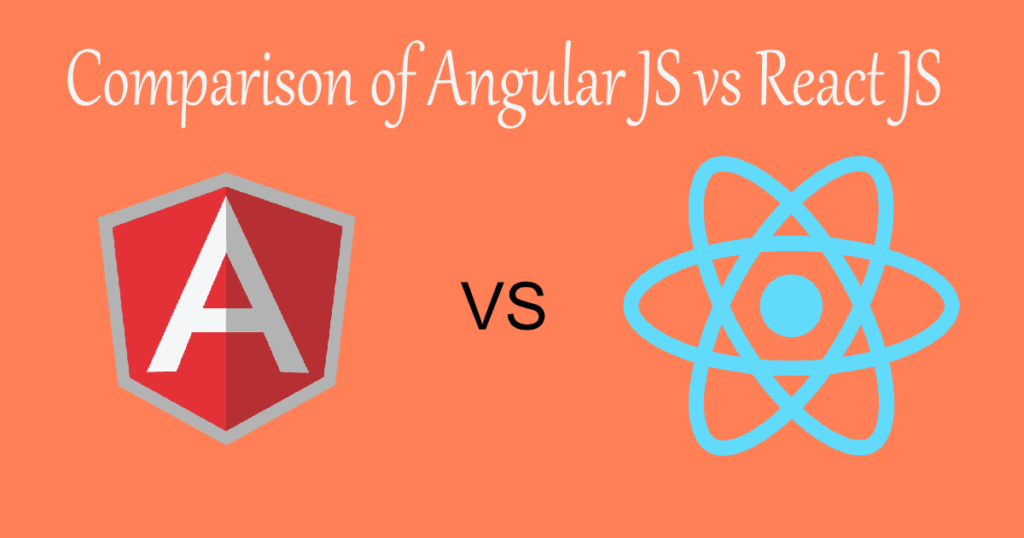The reason of this article is to give you some easy functionality using Angular JS and React JS to provide you an accepting as to what it would take to find an application off the ground. Comparing Angular JS vs React JS, Angular is the big competition in this fight, but React gets improved rendering performance to the table. The documentation for Angular and React is also pretty good. I’m hopeful that after you read this, you’ll have a better understanding as to which framework is correct for you to use on your next project.
Angular JS vs React JS

Angular JS

Angular JS is a web application development framework, and similar to all other frameworks, it offers many out-of-the-box solutions and many functional design results are just arranged by the framework. Angular has been covering for a while now, with its first release in 2009. Since then, it does appear a long way, and they’re up to version 1.3.8 now. Lately, there’s been some news about Angular 2.0, which is going to alter a lot about the framework. The current Angular version utilizes various custom HTML elements and attributes to give functionality on various DOM elements. These are called directives and are very adaptable.
React JS

React JS is an open-source JavaScript library provided that a view for data rendered as HTML. React views are usually rendered using components that include additional components individual as custom HTML tags. React assures programmers a model in which sub-components cannot openly affect enclosing components capable updating of the HTML document when data changes and a clean separation between components on a modern single-page application.
The Angular method uses to inject data into directives is via scopes. In Angular Scope object which contains data for different controls, like directives and controllers.
RENDERING
The first difference is that React JS puts HTML into JavaScript while Angular JS puts JavaScript into HTML. Surely, the approach of Angular JS is more suitable for many frontend web developers. In addition, putting HTML into JavaScript has been considered an awful practice for a long time now. The React JS development team explained the foundation behind this decision very well “We strongly consider that component are the right way to divide concerns rather than “templates” and “display logic.” We think that markup and the code that creates it are intimately tied together. Additionally, display logic is often very difficult and using template languages to express it becomes unwieldy.
We’ve found that the greatest solution for this problem is to generate HTML and component trees straight into the JavaScript code such that you can apply all of the significant power of a real programming language to build UI’s.
Without JSX, I would absolutely vote for the Angular JS approach. However, JSX helps to construct more readable UI component code which creates life considerably easier. Still, developers will get some time to get comfortable with JSX.
Comparing Angular JS vs React JS
The second difference is that React JS has been a “one-way binding” tool from the very opening. Angular JS 1.x was a “two-way binding” tool. While “two-way binding” was an excellent approach appreciated by many developers, in Angular JS 2.x, it was dropped. The binding mechanism is completely dissimilar. It gives wider functionality in Angular JS 2.x compared to React JS. We’ll have to stay and notice how it works in Angular JS 2.x. In React JS, the one-way rendering flow is very fast, straightforward, and debugs, easy to recognize, and trace in comparison to “two-way binding” implement in Angular JS 1.x.
In Angular JS 2.x, the new change detection approach is coming. It’s intended to be based on change detector classes generated at runtime. They also say it’s going to be very fast. The React JS change detection approach is support from Virtual DOM, which means that React JS differentiate the DOM changes new state to the previous state based on renders. This approach is simple to understand and easily trace with React JS debug add-ons. Even if the Angular JS 2.x approach has improved performance, I still think the React JS approach will remain simpler and great.
Two-way binding: Indicates that changes made the parent or child scope are reflecting in the other. When building the scope it’s denoted by an equals sign (=).
One-way binding: Data flows the only function from child to parent. Denoted by an ampersand (&).
Text binding: It contains no binding information, just a string value. Denoted by a symbol (@).
IDE TOOLS
Angular JS development doesn’t need anything individual, so you can continue to use your favorite IDE with JavaScript maintain without any issues. With Angular JS 1.x, you will possibly need to use ES5, with Angular JS 2.x, it’s going to be TypeScript, and you’ll control templates in HTML files for both of them.
With React JS, you can observe code written in ES5, ES6 or even TypeScript, plus you may have to write JSX. This variation may cause issues with decision making .IDE supports all these things is Web Storm. If you use Microsoft Visual Studio, go for TypeScript and ES5; just install an extension that translates JSX into ES5 JavaScript first. If you choose to go with ES6, more work will be essential and you’ll most likely need to apply an editor like Atom in conjunction with Microsoft Visual Studio.
LEARNING PATH
The learning path of the React JS framework isn’t all that easy, but it’s still simple than the learning path of Angular JS. To get started with Angular JS, where you come across complications and sometimes fight with the framework/libraries is much simple with React JS development.
Difference between AngularJS vs ReactJS in Tabular Form
| Technology | AngularJS | ReactJS |
|---|---|---|
| Developer | ||
| Technology type | Full-fledged MVC framework written in JavaScript | JavaScript library (View in MVC; requires Flux to implement architecture) |
| Concept | Brings JavaScript into HTML Works with the real DOM Client-side rendering | Brings HTML into JavaScript Works with the virtual DOM Server-side rendering |
| Data binding | Two-way data binding | One-way data binding |
| Dependencies | Manages dependencies automatically | Requires additional tools to manage dependencies |
| Language | JavaScript + HTML | JavaScript + JSX |
| Last version | AngularJS 1.6.0 RC2 | React 15 |
| Suits best | Best for SPAs that update single view at a time | Best for SPAs that update many views at a time |
weldone !